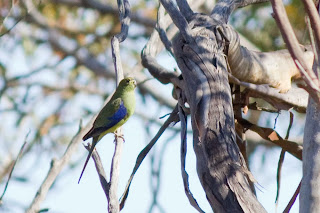Fortunately, with our good conditions here in Adelaide and the dry conditions inland, it seems like we're going to have a good influx of seasonal visitors. There's also already plenty of breeding going on, the resident red wattlebirds at my place already have one almost independent young and everywhere I've been I've seen adult birds collecting food for their chicks.
Musk Lorikeet, Glossopsitta concinna, at Cobbler Creek Recreation Park
However, no matter what the season, the birding tends to be what you make of it, and you never see the seasonal visitors and occasional vagrants unless you go out and look for them in the first place. The same goes with resident birds, there's been white-winged fairy wrens at Whites Road Wetlands for a very long time, but I'd never found them before until I asked somebody exactly where to look, then find them I did. That occasion gave me my very first views of a male bird, and though a very large crop of a poor photograph, I feel compelled to share an image.
Male White-winged Fairywren, Malurus leucopterus, at Whites Road Wetlands
A few days prior to visiting Whites Road, I had been up to Pengilly Scrub to check for seasonal visitors. That visit was my first experience of Rufous Songlark, and they absolutely filled the place. It was near impossible to hear any other bird due to the constant calling of them, they drowned everything except the woodswallows out. Because of this experience, I was able to immediately ID a Rufous Songlark at Whites Road from the call. It's strange to come across something you're sure you've never heard before, then all of a sudden it's everywhere.
Kestrel morph Brown Falcon, Falco berigora, at Pengilly Scrub
After seeing a couple of reports of Blue-winged Parrots at Pengilly Scrub, I once again made the trip up in an attempt to see them. I did my research before-hand, double checking the difference between them and Elegant and listened up on the call. After about 45 minutes at the site I heard their distinctive call as I flushed them out of some long grass and managed to get my eyes on one before it landed. Again, the image is terrible, but the birds were very flighty and would never have let me anywhere near them. Then again, photographing birds isn't always about the quality of the image, it's also about the moment.
Blue-winged Parrot, Neophema chrysostoma
The time spent at Pengilly also allowed me some great opportunities to photograph some nesting woodswallows, this pair were particularly obliging and I have included some video from that session with them.
Dusky Woodswallow, Artamus cyanopterus
All that's left to do now, is to keep going back out into the great outdoors at the promise of more birds, more photography, and more fun.
Black Swan, Cygnus atratus, on nest. Greenfields Wetlands (North Magazine rd site)




















































































